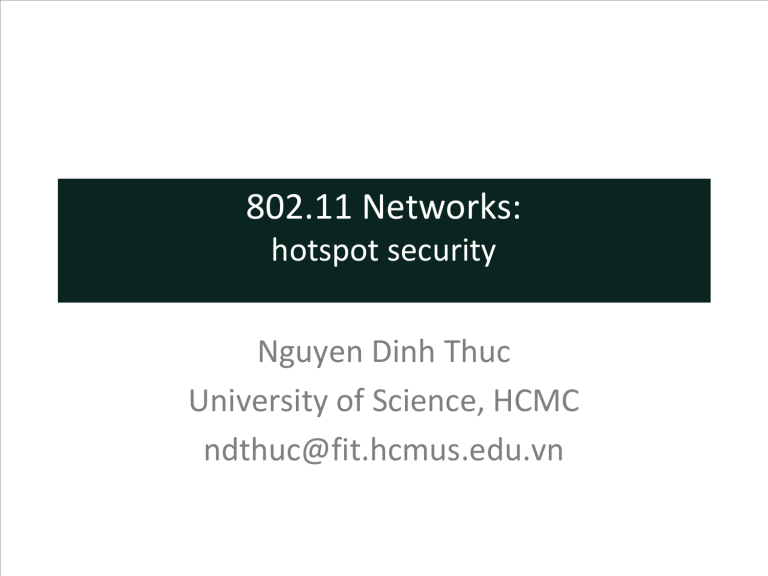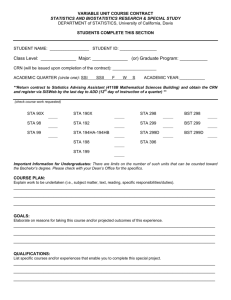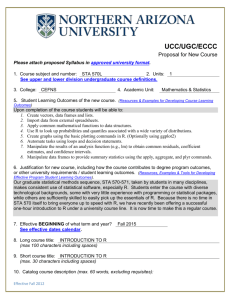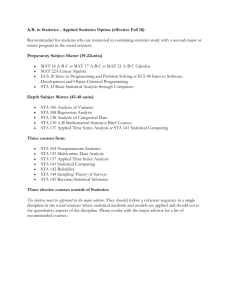Dis'ing attacks on 802.11 networks

802.11 Networks: hotspot security
Nguyen Dinh Thuc
University of Science, HCMC ndthuc@fit.hcmus.edu.vn
Introduction
wireless LAN
Laptop
Internet
10010101
Mobile
Pocket PC
Access Point
01010101
Laptop
Wireless LAN
Wired LAN
Palm
Introduction
wireless security
Privacy
Availability
Integrity
01010101
Availability
• Defending against Dis’ing attacks
• Determining hot-IPs
4
Dis’ing attacks on 802.11 networks:
Introduction
• In the current IEEE 802.11 standards, whenever a wireless station wants to leave the network, it sends a deauthentication or disassociation frame to the access point.
• These two frames, however, are sent unencrypted and are not authenticated by the access point.
• Therefore, an attacker can launch a DoS attack by spoofing these messages and thus disabling the communication between these wireless devices and their access point.
Dis’ing attacks on 802.11 networks:
Farewell attacks
To break the communication between STAs and their AP, an attacker can simply send out a spoofed deauthentication or disassociation frame.
There are a number of tool that enable an attacker to spoof the source MAC address of any device, such as: Spoof-MAC,
Airsnarf, Mac Changer. Note that attacker spoofs a deauthentication or a disassociation frame of AP with broadcast destination MAC address, the effectively all STAs associated to the AP will be disconnected.
The Farewell attack is simple but can cause serious damage, because the attacker can stop the communication using only limited resources without requiring any special technical skill.
Bellardo et al. implement the attacks and show that this attack is simple and effective.
J. Bellardo and S. Savage. 802.11 Denial-of-Service attacks: real vulnerabilities and pratical solutions. In Proceedings of the 12 th conference on USENIX Security Symposium, pages 18-25,
Washington, DC, 2003.
Dis’ing attacks on 802.11 networks:
Some of Defending Solutions
• Approach: eliminating the deauthentication and disassociation frames, or enqueueing them for a fix interval of time (for instance, 10 seconds)
Issues: there may be a period of time where a STA associates with multiple APs concurrently, which may cause routing/handoff problems
• Approach: using Reverse Address Resolution Protocol (RARP) to detect spoofed frames
Issues: the attackers may spoof the IP address of the client to break the
RARP.
• Approach: detecting spoofed frames based on frame sequence number
Issues: the attacker may sniff the frames sent by the client to predict the sequence number of the next frame.
• Approach: developing a lightweight authentication protocol for management frames, such as using 1 bit for authentication.
Issues: errors in wireless medium may break the authentication, and the probability of an attacker to guess the authentication bit correctly is high (50%)
Dis’ing attacks on 802.11 networks: letter-envelop protocol
The protocol works based on a one-way function f(.): given y = f(x), it is computationally infeasible to compute x; However, given x, it is easy to compute N. The Letter-envelop protocol is as follows:
1.
Initially, STA randomly generates x
1
, then computes y
1
= f(x
1
).
Similarly, AP generates x
2 to the AP, and AP sends y
2 and computes y
2
= f(x
2
).
2.
During the authentication process between STA and AP, STA sends y
1 to the STA.
3.
When the STA wants to disconnect from the AP, it sends either the deauthentication or the disassociation frame to the AP, together x
1 the AP. If f(x
1
) = y
1 to then the frame is authenticated and will be procceed accordingly. Otherwise, the frame is rejected.
4.
Similarly, if the AP wants to disconnect from the STA, it sends the disassociation/deauthentication frame together x
2
.
The STA disconnects itself from the AP if f(x
2
)=y
2
.
Dis’ing attacks on 802.11 networks: letter-envelop protocol
STA −−−−−→ AP
Connection process
Authentication
Association
STA −−−−−→ AP
Connection process
Authentication
STA −−−−−→ AP
Connection process
Authentication
Generate x
1 y
1
= f(x
1
) y
1
−−−−−−−−−−−→ y
2
←−−−−−−−−−−− y
2
=f(x
2
) is already computed
Ass.
request
Generate x
1
Compute y
1
=f(x
1
)
−−−−−−−−−−−−−→ y
1
Data exchange Data exchange
Generate x i
Compute y i
=f(x i
) y
2
←−−−−−−−−−−−−−
(a) Original
Association
(b) Modified
Association
(c) Modified
Association (special case)
Thuc D. Nguyen, Duc H. M. Nguyen, Bao N. Tran†,Hai Vu, Neeraj Mittal, A lightweight solution for defending against deauthentication/disassociation attacks on 802.11 networks , In IEEE 17th International Conference on Computer
Communication and Networks (ICCCN), St. Thomas, US Virgin Islands, August 2008
Dis’ing attacks on 802.11 networks: implementation of letter-envelop protocol
Thuc D. Nguyen, Duc H. M. Nguyen, Bao N. Tran†,Hai Vu, Neeraj Mittal, A lightweight solution for defending against de-authentication/disassociation attacks on
802.11 networks , In IEEE 17th International Conference on Computer
Communication and Networks (ICCCN), St. Thomas, US Virgin Islands, August
2008
Dis’ing attacks on 802.11 networks: implementation of letter-envelop protocol
The configuration of our system is as follows:
• One PC (CPU: Intel Celeron 3GHz, RAM: 1GB, HDD: 80GB) functioning as an
AP.
• One PC (CPU: Intel Celeron 1.73GHz, RAM: 512MB, HDD: 80GB) functioning as a legitimate STA. this STA continuously sends ICMP ping packets to the AP to check the connection with the AP.
• One PC (CPU: Intel Core Duo 1.6GHz, RAM: 512MB, HDD: 80GB) running
CommView for Wifi to launch the Farewell attack.
We continuously send deauthentication and disassociation frames with spoof
MAC address of the STA (to the AP) and of the AP (to the STA) at rate 10 frames/second. If AP can detect the frame to be a spoofed frame, they will ignore the frame and will not disconnect the STA. otherwise it will disconnect the STA and clear information related to that STA in the memory.
The result of the experiments show that our solution is completely effective against the Farewell attack, none of the attacks is successful.
Availability
• Defending against Dis’ing attacks
• Determining hot-IPs
12
Computing heavy hittes
• Cormode and Muthukrishnan consider the following problem of determining “hot items" or "heavyhitters.“ in a given sequence of items from [n], an item is considered hot" if it occurs > m=(d + 1) times; where d is a given constant.
• Note that there can be at most d hot items.
G. Cormode and S. Muthukrishnan. What's hot and what's not: tracking most frequent items dynamically. ACM Trans. Database Syst., 30(1):249{278, 2005.
Algorithm of Cormode-Muthukrishnan
• Cormode and Muthukrishnan proposed an algorithm based on Non-Adaptive Group Test (NAGT) that computes all the hot items as long as the input satises the following “small tail” property: all of the non-hot items occur at most m=(d + 1) times.
• Let M be a d- disjunct t n matrix . For each test i [t], maintain a counter c i
. When an item j [n] arrives
(leaves respectively), increment (decrement respectively) all the counters c seen so far. i such that M ij
= 1. The algorithm also maintains the total number of items m
Disjunct-matrix
M
• A binary t N matrix is said to be disjunct if the union (or Boolean sum) of any d d columns does not contain any other column.
0 0 1 0 0 1 1
0 0 1 0 1 0 0
0 0 1 1 0 0 0
0 1 0 0 0 1 0
0 1 0 0 1 0 1
0 1 0 1 0 0 0
1 0 0 0 0 1 0
1 0 0 0 1 0 0
1 0 0 1 0 0 1
, d
2, N
7, t
9 N
1 1 1 0 1 1
1 1 0 1 1 0
1 0 1 1 0 0
1 0 0 0 0 0
0
0
0
0
0
1
0
0
0
0
0
1
0
0
0
0
0
1
0
0
0
0
0
1
1
0
0
1
1
0
, d
2, N
6, t
9
Determining hot-IPs
• Let n be number of IP address and d be maximum number of IPs which can been attacked.
• Given a sequence of IPs, the problem is to find those IPs which occur most frequently. This is formalized as finding all IPs whose frequency exceeds a specified fraction of the total number of
IPs.
• This problem can been solved by using group test method
Algorithm
Let
• M be d-disjunct t n matrix
• C := (c
1
,…,c t
) N t
• R:=(r
1
,…,r t
) {-,+} t
• IP [n]*: sequence of IPs.
c
c c
1
...
2 t
m
11 m
21 m
...
t 1 m m m
...
t
12
22
2
...
...
...
...
m m
...
1 n m
2 n tn
• For j=1 to t do c j
• For each i IP,
=0 for j=1 to t do if m ij
=1 then c j
++
• For j=1 to t do
If c j
>d then r j
Else r j
=-
=+ r r
1
2 r
...
t
Example
IP
{ 1 , 1 , 3 , 5 , 1 , 6 , 5 , 4 , 1 , 5 }, d
IP
2
4
2
1
3
1
5
7
5
1
1
1
1
2
1
1
1
3
1
1
1
4
1
1
1
5
1
1
1
6
1
1
1
2
7
1
1
1
Determining hot-IPs
• Given R {-,+}t
• Find hot-IPs
m m
21 m
...
11 t 1 m
12 m
22
...
m t 2
...
...
...
...
m
1 n m
2 n m
...
tn
r r
1
2 r
...
t
• With each r i
=- do for i=1 to n do if (m ij
)=1 Then
IP:=IP\{j}
• Return IP
Example
IP
1
1
1
1
{ 1 , 1 , 3 , 5 , 1 , 6 , 5 , 4 , 1 , 5 },
2
1
1
1
3
1
1
1
4
1
1
1
5
1
1
1
6
1
1
1
2
7
1
1
1






